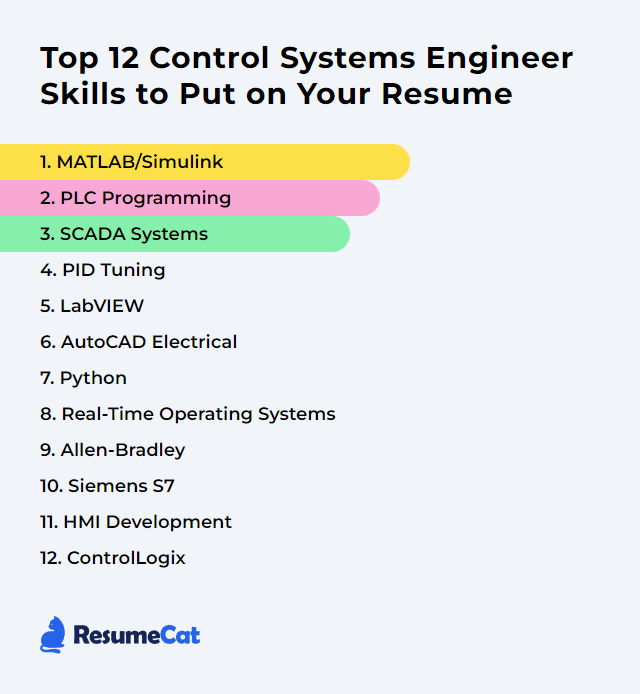Top 12 Control Systems Engineer Skills to Put on Your Resume
In the rapidly evolving field of control systems engineering, having a standout resume matters. Showcasing a sharp, relevant skill set doesn’t just prove capability; it signals you can ship robust systems, troubleshoot under pressure, and keep complex processes humming without drama.
Control Systems Engineer Skills
- MATLAB/Simulink
- PLC Programming
- SCADA Systems
- PID Tuning
- LabVIEW
- AutoCAD Electrical
- Python
- Real-Time Operating Systems
- Allen-Bradley
- Siemens S7
- HMI Development
- ControlLogix
1. MATLAB/Simulink
MATLAB/Simulink is a staple for modeling, simulation, and analysis of dynamic systems. MATLAB handles algorithms, data, and visualization. Simulink brings block diagrams to life for rapid prototyping of control and signal-processing designs. Together, they shorten the distance from concept to tested controller.
Why It's Important
It offers a unified environment to design, simulate, and refine control strategies before they ever touch hardware—faster iteration, fewer surprises, better performance.
How to Improve MATLAB/Simulink Skills
Level up by blending fundamentals with deliberate practice and real projects:
Nail the basics: Core MATLAB syntax, vectorization, and Simulink modeling patterns. Clean models, clear data flow.
Use Control System and related toolboxes: Work with linear analysis, PID tuning, and frequency-domain methods directly in the environment.
Model-based design: Build plant models, linearize, iterate controllers, and validate with Monte Carlo and Hardware-in-the-Loop when possible.
Templates and patterns: Reuse subsystems, data dictionaries, and bus objects to keep large models maintainable.
Verification: Assertions, test harnesses, and scripting for regression tests. Treat your model like code.
Keep current: New releases often add solver improvements, code generation gains, and tuning workflows worth adopting.
Hands-on projects seal the learning. Simulate, then validate on target hardware when you can.
How to Display MATLAB/Simulink Skills on Your Resume
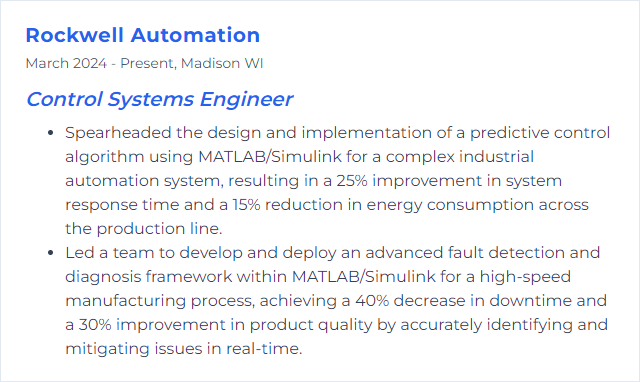
2. PLC Programming
PLC programming means crafting logic—ladder, structured text, function blocks—to automate processes and keep machines safe, coordinated, and observable.
Why It's Important
It anchors industrial automation. Reliable logic reduces downtime, enforces safety, and drives consistent production.
How to Improve PLC Programming Skills
Foundations first: Scan cycles, task priorities, I/O mapping, debouncing, state machines, and fail-safe design.
Standards matter: IEC 61131-3 languages and naming conventions keep projects readable and transferable.
Simulate early: Use vendor simulators to test logic before commissioning. Catch race conditions and latching mistakes.
Structured design: Modular programs, reusable function blocks, and clear alarms. Version control everything.
Diagnostics: Build in status bits, heartbeat signals, and trend-friendly tags for faster troubleshooting.
Real projects: Small conveyor, tank level control, or batching logic—practice end to end, including HMI and interlocks.
Keep learning: Explore vendor-specific features like motion, safety, and PID blocks to broaden your toolset.
How to Display PLC Programming Skills on Your Resume
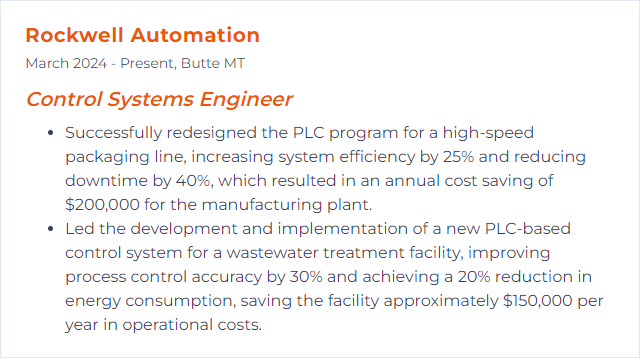
3. SCADA Systems
SCADA provides supervisory control and data acquisition across sites and systems. Sensors report in, operators act, trends tell stories. Centralized, watchful, scalable.
Why It's Important
It delivers real-time visibility and control, improves uptime, and supports safety and compliance across distributed assets.
How to Improve SCADA Systems Skills
Security first: Segment networks, apply least privilege, enforce MFA where supported, and align with ISA/IEC 62443 practices.
Open, interoperable architectures: Favor standard protocols (OPC UA, Modbus, IEC 104) and modular components to simplify upgrades.
Data done right: Use robust historians, consistent tag naming, and clear engineering units. Archive what you need, not everything.
Edge where it counts: Preprocess near the source to cut bandwidth, latency, and noise.
Redundancy: Hot-standby servers, redundant comms paths, and failover testing. Don’t just configure it—prove it.
Operator UX: Clean screens, meaningful alarms, trend overlays, and contextual diagnostics. No blinking clutter.
Lifecycle discipline: Patch plans, backup schedules, test environments, and clear change control procedures.
How to Display SCADA Systems Skills on Your Resume
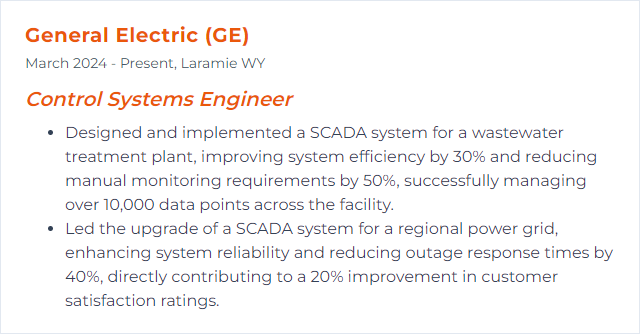
4. PID Tuning
PID tuning sets the proportional, integral, and derivative gains so systems respond quickly without going wild—tight control, minimal overshoot, steady-state accuracy.
Why It's Important
Good tuning stabilizes plants, reduces wear, saves energy, and keeps product quality steady.
How to Improve PID Tuning Skills
Know the plant: Time constants, dead time, nonlinearity, noise. Model if you can; estimate if you must.
Start simple: Zero I and D, raise P to the cusp of oscillation, then back off. Layer in I to remove bias, D to tame overshoot.
Use methods: Try Ziegler–Nichols, Cohen–Coon, IMC, or relay auto-tuning as baselines, then refine with closed-loop tests.
Mind constraints: Rate limits, saturation, anti-windup, filtering on D. Stability first, elegance later.
Tools help: Analyze step responses, bode plots, and noise sensitivity in simulation before touching the plant.
Retune when things change: Different loads, temperatures, or wear can shift dynamics. Revalidate periodically.
It’s always a trade: speed, stability, and robustness. Balance them for your process.
How to Display PID Tuning Skills on Your Resume
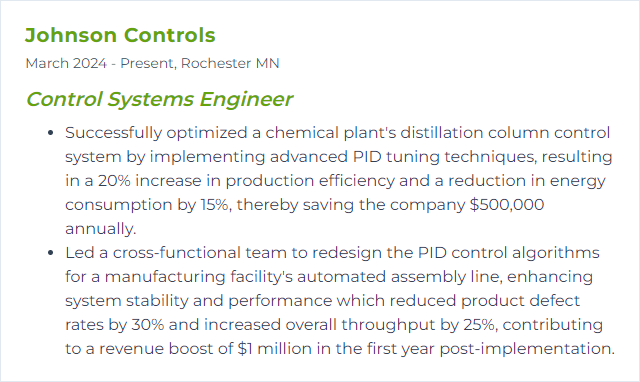
5. LabVIEW
LabVIEW is a graphical development environment for test, measurement, and control. Drag wires, drop nodes, build deterministic systems fast—especially when paired with DAQ and real-time targets.
Why It's Important
It accelerates prototyping and deployment of control and test rigs, while staying readable and modular for teams.
How to Improve LabVIEW Skills
Core patterns: Producer–consumer loops, queued message handlers, and error clusters. Make concurrency intentional.
DAQ and timing: Master hardware-timed operations, buffering, and synchronization across devices.
Real-time and FPGA: When determinism matters, use the Real-Time Module and offload critical paths to FPGA where appropriate.
Style and reuse: Typedefs, libraries, and packed project libraries. Consistent icons and documentation.
Testing: Unit test frameworks and VI analyzer to keep technical debt from sneaking in.
Certifications: CLAD, CLD, and CLA offer clear milestones and enforce good habits.
How to Display LabVIEW Skills on Your Resume
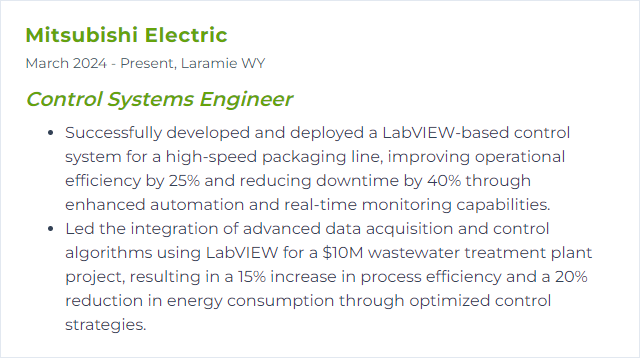
6. AutoCAD Electrical
AutoCAD Electrical speeds up control schematics, panel layouts, and wiring documentation with symbol libraries, cross-referencing, and error checking baked in.
Why It's Important
It reduces rework, enforces standards, and keeps drawings consistent across teams and projects.
How to Improve AutoCAD Electrical Skills
Templates and standards: Establish title blocks, layers, and naming early. Enforce IEC/ANSI symbology consistently.
Shortcut fluency: Commands at your fingertips mean faster iterations and fewer clicks.
Custom palettes: Surface the blocks, macros, and scripts you use daily. Trim the friction.
Circuit Builder and reports: Auto-generate ladders, wire numbers, BOMs, and terminal plans—then validate with error checking.
Automate: Use AutoLISP or .NET to handle repetitive tasks and batch updates.
Revision control: Manage drawing sets with clear versioning and change tracking to avoid shop-floor confusion.
How to Display AutoCAD Electrical Skills on Your Resume

7. Python
Python powers control algorithms, data pipelines, simulations, and glue code. Quick to write, rich in libraries, easy to share.
Why It's Important
With NumPy, SciPy, pandas, Matplotlib, and control-focused packages, you can model plants, tune controllers, analyze logs, and visualize outcomes—fast.
How to Improve Python Skills
Core fluency: Data structures, comprehensions, OOP, and clean coding practices. Write readable modules with tests.
Numerical stack: NumPy, SciPy, pandas for time-series and signal work. Vectorize where possible.
Visualization: Matplotlib/Seaborn for crisp plots; interactive dashboards when stakeholders need live insights.
Control-specific: Explore the python-control library and simulation frameworks. Build closed-loop sims and compare strategies.
Tooling: Jupyter for exploration, virtual environments for isolation, linters/formatters for consistency.
Projects: Sensor ingestion, state estimation, parameter identification, and controller prototyping—ship small, iterate.
How to Display Python Skills on Your Resume
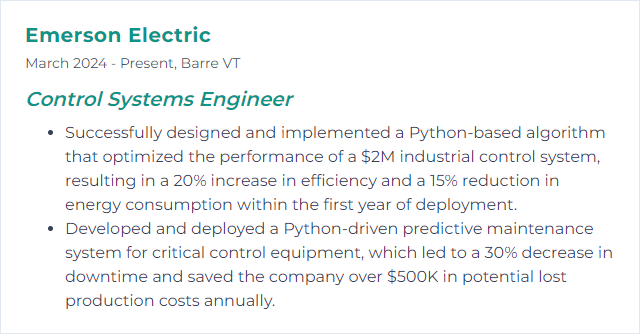
8. Real-Time Operating Systems
RTOS platforms enforce timing guarantees. Tasks, interrupts, and resources are scheduled predictably—vital when milliseconds matter.
Why It's Important
Determinism keeps control loops stable, protects safety envelopes, and ensures repeatable behavior under load.
How to Improve Real-Time Operating Systems Skills
Scheduling strategy: Choose Rate Monotonic or Earliest Deadline First thoughtfully. Map tasks to priorities with margin.
Latency hygiene: Keep ISRs short, avoid blocking calls, and reduce context-switch churn.
Memory discipline: Prefer static allocation and pools. Avoid fragmentation and unbounded allocation in real time.
Concurrency control: Priority inversion protection, lock-free queues where sensible, and careful use of mutexes/semaphores.
Tracing and profiling: Use run-time tracing to spot missed deadlines, jitter, and starvation.
Testing under stress: Load, noise, and fault injection. Prove timing holds in worst-case scenarios.
Platform depth: Explore ecosystems like FreeRTOS, Zephyr, VxWorks, or QNX to understand tradeoffs and tooling.
How to Display Real-Time Operating Systems Skills on Your Resume
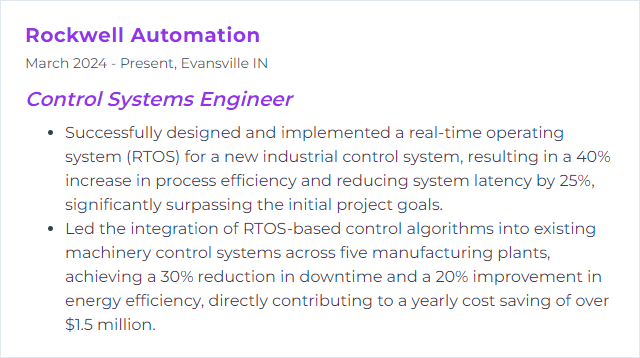
9. Allen-Bradley
Allen-Bradley (Rockwell Automation) gear—PLCs, HMIs, drives, safety—shows up everywhere. Studio 5000 ties it together for programming and configuration.
Why It's Important
Widespread adoption, deep feature sets, and robust ecosystems make it a safe bet for complex industrial automation.
How to Improve Allen-Bradley Skills
Studio 5000 mastery: Tasks, periodic vs. continuous, AOIs, UDTs, and motion/safety add-ons.
Emulation and labs: Practice with Studio 5000 Logix Emulate when hardware is scarce. Test comms, interlocks, and I/O logic.
Read the manuals: Controller, module, and networking guides answer 90% of commissioning mysteries.
Diagnostics: Use trend objects, controller status, and cross-references to debug quickly.
Keep current: Firmware alignment and compatibility checks prevent painful surprises.
Community and training: Courses, forums, and knowledgebases accelerate troubleshooting patterns.
How to Display Allen-Bradley Skills on Your Resume
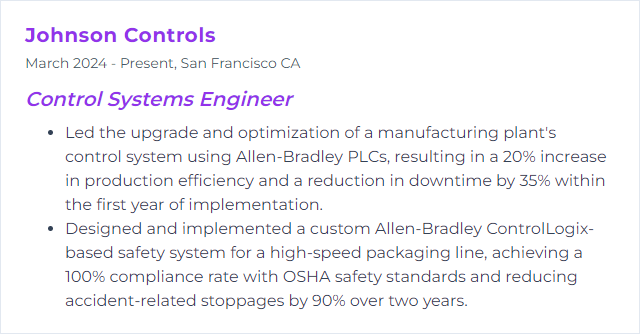
10. Siemens S7
Siemens S7 PLCs and TIA Portal form a flexible automation platform with powerful diagnostics, motion, and networking (including PROFINET) options.
Why It's Important
They’re ubiquitous in many regions and industries, with scalable hardware and rich software tools suited for everything from small machines to large plants.
How to Improve Siemens S7 Skills
Code efficiency: Optimize OB/FB/FC structures, minimize scan times, and keep data blocks organized and documented.
Firmware and libraries: Keep controllers, HMIs, and drives updated; leverage official libraries for common tasks.
Networking: Structure comms thoughtfully, trim broadcast noise, and use real-time features when your application demands it.
Diagnostics and maintenance: Use TIA diagnostics, trace tools, and online monitoring to speed commissioning and support.
Training and practice: SITRAIN courses and hands-on projects build the instincts that documentation alone can’t.
How to Display Siemens S7 Skills on Your Resume
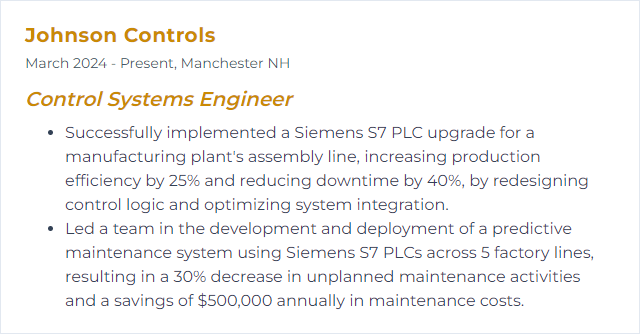
11. HMI Development
HMI development turns complex processes into clear screens with meaningful controls and alarms. Operators see what matters, when it matters.
Why It's Important
Good HMIs cut errors, boost responsiveness, and make training easier. In critical moments, clarity saves time.
How to Improve HMI Development Skills
User-centered design: Watch operators work. Map tasks, pain points, and must-have context. Build for real workflows.
Simplicity: Only necessary data on primary screens. Use drill-downs for detail. Consistent color and symbols.
Alarm philosophy: Prioritize, suppress chatter, and make alarm messages actionable. Fewer, better alarms.
Feedback and responsiveness: Immediate, unambiguous responses to user actions. Clear states and confirmations.
Accessibility: Legible fonts, sufficient contrast, scalable layouts, and input methods suitable for gloves or touch panels.
Security: Roles, audit trails, and safe modes. Lock down critical commands.
Iterate with users: Prototype, test on the floor, refine. Repeat until the screens disappear into the work.
How to Display HMI Development Skills on Your Resume
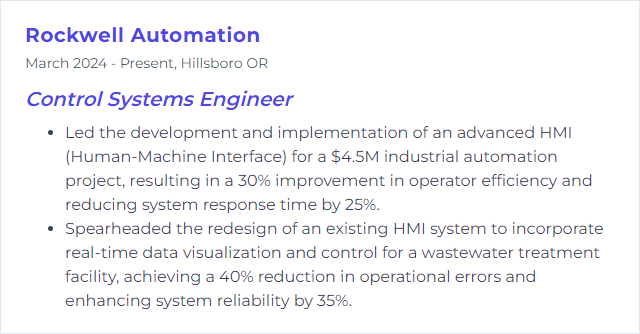
12. ControlLogix
ControlLogix is Rockwell’s modular PAC platform—scalable controllers, high-speed I/O, and Ethernet/IP communications for demanding industrial control.
Why It's Important
It supports complex, integrated systems with motion, safety, and extensive diagnostics—reliable under heavy workloads.
How to Improve ControlLogix Skills
Lean logic: Keep routines simple, reduce nesting, and choose efficient instructions to lower scan time.
Data structures: Use UDTs and arrays sensibly; align data for readability and performance.
Network design: Segment traffic, use managed switches, and tune QoS for time-critical messages.
Produced/consumed tags: Powerful but heavy—employ them sparingly and document update rates clearly.
Firmware alignment: Match controller, chassis, and module firmware to avoid compatibility headaches.
I/O strategy: For ultra-critical loops, prefer local or low-latency connections. Verify RPI settings suit the process.
Observe and optimize: Use Studio 5000 diagnostics, trends, and task monitors to spot bottlenecks early.
Continuous learning: Training, labs, and field notes keep your mental toolbox sharp.
How to Display ControlLogix Skills on Your Resume

